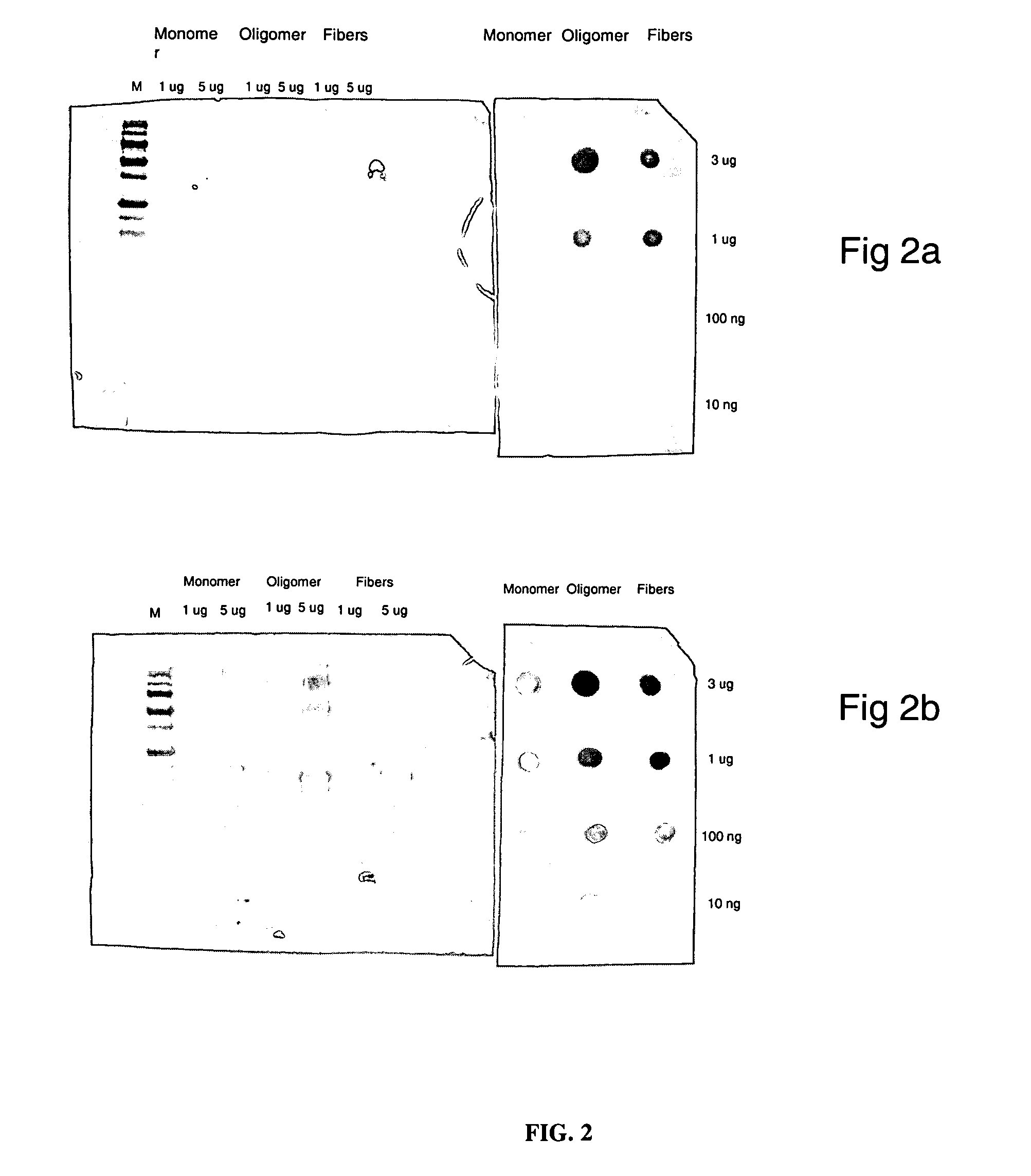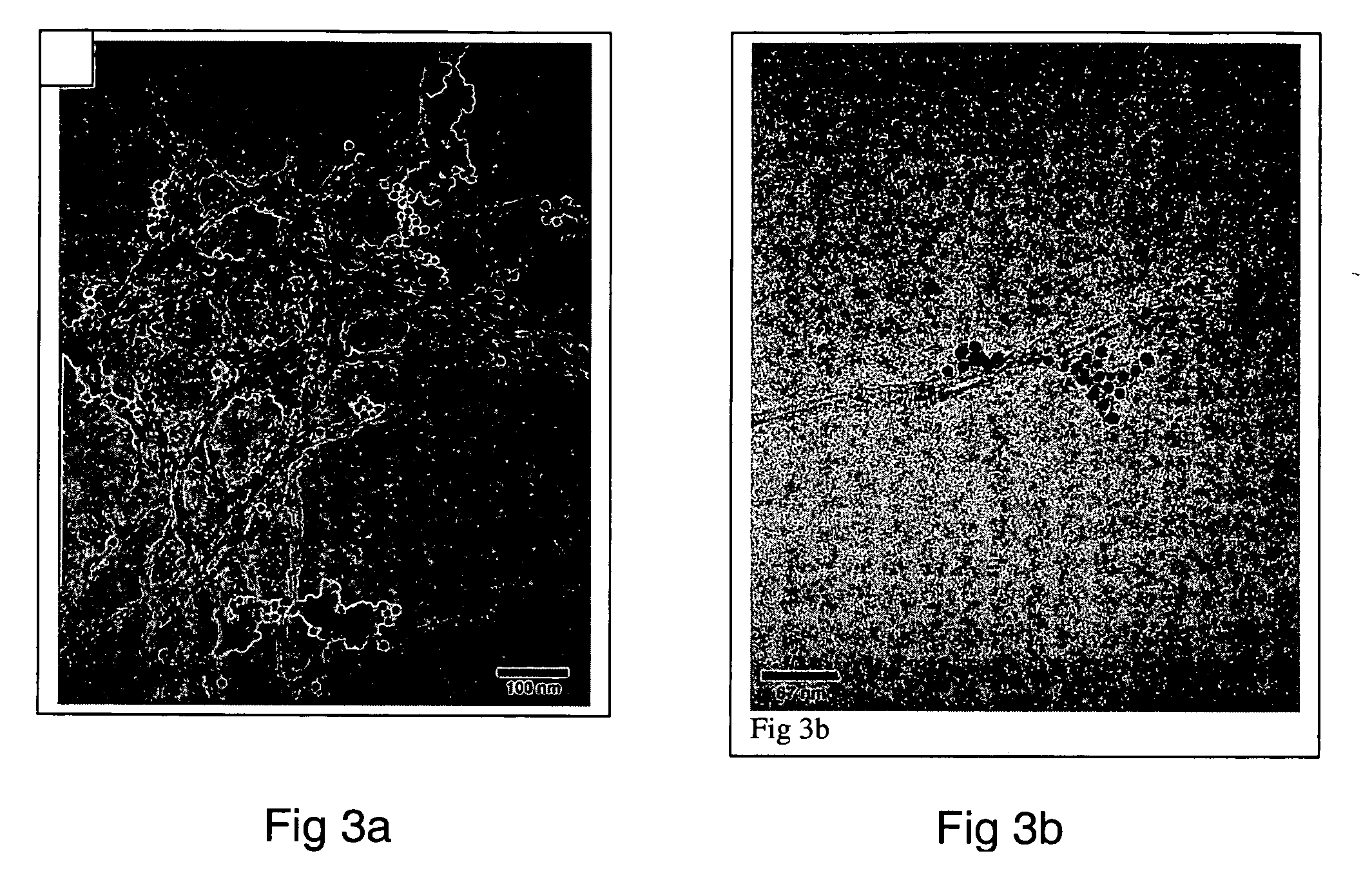Monoclonal antibody
- Summary
- Abstract
- Description
- Claims
- Application Information
AI Technical Summary
Benefits of technology
Problems solved by technology
Method used
Image
Examples
example 1
Methods for Making Palmitoylated Aβ1-15 Supramolecular Antigenic Constructs
[0426] Synthesis of Tetra(Palmitoyl Lysine)-Aβ1-15 Peptide Antigen:
[0427] The palmitoylated amyloid 1-15 peptide was synthesized following an improved previously reported method (Nicolau et. al. 2002). This new approach involved on-resin grafting of palmitic acid to the terminal Lys residues of the pre-formed peptide rather than stepwise solid-phase synthesis incorporating the modified amino acid 9-fluorenylmethoxycarbonyl (Fmoc)-Lys(Pal)-OH. This new approach improves coupling efficiency and gives a product of considerably higher purity. Thus, the orthogonally protected amino acid Fmoc-Lys(Mtt)-OH was attached to a Wang resin using [2-(1H-benzotriazol-1-yl)-1,1,3,3-tetramethyluronium hexafluorophosphate] (HBTU) coupling chemistry. The Fmoc group was removed using 20% piperidine in DMF and a second residue of Fmoc-Lys(Mtt)-OH was coupled. Standard automated peptide synthesis using Fmoc / tBu chemistry and sta...
example 2
Methods for Making Supramolecular Antigenic Constructs
[0428] Synthesis of Pegylated β-Amyloid Peptide Antigen:
[0429] To enhance the immune response, another anchor / spacer has been applied to reconstitute the peptide in the liposome, e.g. polyethylene glycol (PEG). PEG was covalently attached to the lysine residue bound at both termini of the peptide. At the other end of the chain (PEGn=70) phosphatidyl ethanol amine (PEA) was covalently bound to function as the anchoring element in the liposome bilayer. Thus, the liposome still functions as an adjuvant and the peptide being sufficiently far away from the bilayer can be processed alone and thus increases its immunogenicity as compared to the palmitoylated antigen.
[0430] The supramolecular constructs described herein were uniquely synthesized using standard Fmoc / tBu amino acid side-chain protections. Typically, pegylation of peptides results in mixtures of regioisomers. Herein a convenient method for the site-specific attachment of...
example 3
Antibodies Elicited by Supramolecular Antigenic Constructs
[0436] Manufacturing of mAbs Raised Against Palmitoylated Aβ1-15 Supramolecular Antigenic Construct:
[0437] Palmitoylated antigen (ACI-24, Aβ1-15) was used for the immunization in C57BL / 6 mice in 2 week intervals. 10-12 animals were immunized with each antigen (Injection vol: 200 μl containing 8 mmoles peptid). Last injection was performed 4 days before sacrifice of the animals. After 5 boostings mice with therapeutic titers (when a 1:5,000 dilution of the sera were positive in ELISA) were selected for a fusion. Spleen cells are harvested from the immunized animals and hybridomas generated by fusing sensitized spleen cells with a myeloma cell line. The fusion of the mice's B-lymphocytes from the spleens was conducted with cells of myeloma cell line SP2-0. (ATCC, Manassas, Va.) using the well-known processes of Kohler and Milstein (Nature 256: 495-497 (1975)) and Harlow and Lane (Antibodies: A Laboratory Manual (Cold Spring H...
PUM
| Property | Measurement | Unit |
|---|---|---|
| Temperature | aaaaa | aaaaa |
| Fraction | aaaaa | aaaaa |
| Fraction | aaaaa | aaaaa |
Abstract
Description
Claims
Application Information
 Login to View More
Login to View More - R&D
- Intellectual Property
- Life Sciences
- Materials
- Tech Scout
- Unparalleled Data Quality
- Higher Quality Content
- 60% Fewer Hallucinations
Browse by: Latest US Patents, China's latest patents, Technical Efficacy Thesaurus, Application Domain, Technology Topic, Popular Technical Reports.
© 2025 PatSnap. All rights reserved.Legal|Privacy policy|Modern Slavery Act Transparency Statement|Sitemap|About US| Contact US: help@patsnap.com



